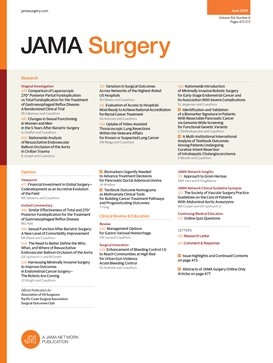Mesh Weight in Reoperation for Recurrence After Laparoscopic Inguinal Hernia Repair.
IF 14.9
1区 医学
Q1 SURGERY
引用次数: 0
Abstract
Importance Previous studies on mesh weights have focused on the definitions of lightweight and heavyweight meshes, which were not based on clinical outcomes. Objective To investigate which mesh weight would be associated with the lowest reoperation rate for recurrence in laparoscopic inguinal hernia repair. Design, Setting, and Participants This nationwide cohort study was based on prospectively collected data on eligible patients aged 18 years or older who had undergone a primary transabdominal preperitoneal laparoscopic inguinal hernia repair in Denmark between January 1998 and July 2023 from the Danish Inguinal Hernia Database, obtained through population-based sampling. The final grouping included patients who received a mesh with a weight of <45 g/m2, 45-65 g/m2, or >65 g/m2. The database linkage to the Danish National Patient Registry made it possible to follow-up patients until the date of data extraction, death, emigration, or reoperation. Sequential explorative analyses were conducted to compare all mesh weight intervals to find the weight interval that resulted in the lowest risk of reoperation for recurrence. Main Outcomes and Measures The main outcome was reoperation for recurrence using a Cox proportional hazards regression model. Results A total of 43 986 inguinal hernias from 36 446 patients were included: 16 949 in the less than 45-g/m2 group, 16 531 in the 45- to 65-g/m2 group, and 10 506 in the greater than 65-g/m2 group. A total of 1910 (4.34%) inguinal hernias underwent reoperation for recurrence. The mesh weight interval of 45 to 65 g/m2 had the lowest risk of reoperation for recurrence. Compared with a mesh weight of 45 to 65 g/m2, a mesh weight of less than 45 g/m2 had a hazard ratio for reoperation of 2.6 (95% CI, 2.2-2.8; P < .001), and a mesh weight of greater than 65 g/m2 had a hazard ratio of 2.4 (95% CI, 2.1-2.8; P < .001) for reoperation. Conclusions and Relevance This nationwide cohort study found that a mesh weight of 45 to 60 g/m2 resulted in the lowest risk of reoperation for recurrence compared with other mesh weights in laparoscopic inguinal hernia repair. These findings suggest that selecting a mesh within 45 to 60 g/m2 can optimize outcomes and reduce the need for reoperation.补片重量在腹腔镜腹股沟疝修补术后复发再手术中的作用。
先前关于网片重量的研究主要集中在轻量级和重量级网片的定义上,而不是基于临床结果。目的探讨腹腔镜腹股沟疝修补术中补片重量与再手术复发率的关系。设计、环境和参与者本全国性队列研究基于前瞻性收集的数据,这些数据来自1998年1月至2023年7月期间在丹麦接受过经腹膜前腹腔镜腹股沟疝修补术的18岁或以上的患者,这些患者来自丹麦腹股沟疝数据库,通过基于人群的抽样获得。最后一组包括接受重量为65 g/m2的补片的患者。与丹麦国家患者登记处的数据库链接使得对患者进行随访成为可能,直到数据提取、死亡、移民或再手术的日期。序贯探索性分析比较所有网格权重区间,以找到导致复发再手术风险最低的权重区间。主要结局和指标采用Cox比例风险回归模型,主要结局为复发再手术。结果36 446例患者共纳入43 986例腹股沟疝:小于45 g/m2组16 949例,45 ~ 65 g/m2组16 531例,大于65 g/m2组10 506例。共有1910例(4.34%)腹股沟疝因复发而再次手术。补片重量间隔为45 ~ 65 g/m2时,再手术复发的风险最低。与目重45 ~ 65 g/m2相比,目重小于45 g/m2的再手术风险比为2.6 (95% CI, 2.2 ~ 2.8; P <。大于65 g/m2的网重的风险比为2.4 (95% CI, 2.1-2.8; P < 0.05)。001)以便重新操作。结论和相关性这项全国性队列研究发现,腹腔镜腹股沟疝修补术中,与其他补片重量相比,补片重量为45 - 60 g/m2的补片复发再手术风险最低。这些研究结果表明,选择45至60 g/m2的补片可以优化结果并减少再次手术的需要。
本文章由计算机程序翻译,如有差异,请以英文原文为准。
求助全文
约1分钟内获得全文
求助全文
来源期刊

JAMA surgery
SURGERY-
CiteScore
20.80
自引率
3.60%
发文量
400
期刊介绍:
JAMA Surgery, an international peer-reviewed journal established in 1920, is the official publication of the Association of VA Surgeons, the Pacific Coast Surgical Association, and the Surgical Outcomes Club.It is a proud member of the JAMA Network, a consortium of peer-reviewed general medical and specialty publications.
 求助内容:
求助内容: 应助结果提醒方式:
应助结果提醒方式:


